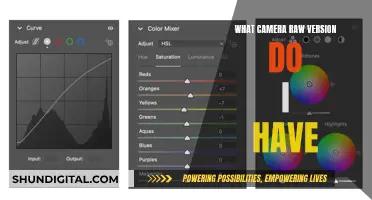
Cameras are incredible tools that allow us to capture and make sense of the world around us. The first camera was essentially a room with a small hole in one wall, known as a camera obscura. Light would pass through the hole and, since it travels in a straight line, the image would be projected onto the opposite wall, upside down.
The basic technology that makes photography possible is fairly simple. A still film camera is made of three elements: an optical element (the lens), a chemical element (the film), and a mechanical element (the camera body). The lens is made of glass or plastic and focuses light onto the film to reproduce an image. The diaphragm is an opening or aperture that controls the amount of light entering the camera. The shutter also limits the film's exposure to light by controlling the length of time the film is exposed. The camera body encloses and protects the operating parts of the camera, including the light meter, film transport system, built-in flash, and electronic and mechanical components.
The invention of roll film in 1889 by George Eastman made photography more portable and affordable. Today, cameras are available in various sizes and shapes to suit different photographers' needs and budgets. The design and manufacture of the lens are critical to the quality of the photos taken. Modern lenses are extremely sophisticated, and image quality depends on each element in the optical formula being precisely cut, shaped, and polished.
| Characteristics | Values |
|---|---|
| Design | An electronic "sketch" is created using CAD (computer-aided design) software |
| Parts | Lens, diaphragm, shutter, viewfinder, LCD screen, electronics |
| Materials | Glass, plastic, polycarbonate compound with glass fiber, optical glass, liquid crystals, LEDs |
| Manufacturing Process | Injection molding, assembly, computer simulation, prototyping, testing, mass production |
| Performance | Shutter speed, film speed, light settings, frequency, durability |
What You'll Learn
- The camera body: a light-tight box that enables light to be captured on film, paper, or a digital sensor
- The lens: a critical component, made of glass or plastic, that redirects light to create a sharp image
- The diaphragm: an aperture that controls the amount of light entering the camera
- The shutter: limits the film's exposure to light by controlling the length of time the film is exposed
- The viewfinder: a specialised lens the photographer uses to preview the photograph

The camera body: a light-tight box that enables light to be captured on film, paper, or a digital sensor
The camera body is the heart of the device, housing the mechanisms that capture images. Essentially, it is a light-tight box that controls the amount of light that reaches a light-sensitive surface, such as film, paper, or a digital sensor. This basic principle has remained unchanged since the early days of photography, but the camera body has evolved to accommodate various formats, styles, and shapes, each serving a specific purpose.
Large format cameras, for example, are designed for sheet film larger than 4x5 inches or digital backs. They are easily recognised by their bellows, giving them an old-fashioned appearance. These cameras offer photographers maximum control over perspective and exposure and are often manually operated, making them a favourite among commercial and fine art photographers. On the other hand, medium format cameras are designed for 120 films and come in a variety of shapes, with Hasselblad and Mamiya being popular manufacturers.
The evolution of camera bodies has led to the creation of SLR (single-lens reflex) and DSLR (digital single-lens reflex) cameras. These cameras, widely used by professionals and serious amateur photographers, offer the ability to change lenses and provide a direct view through the lens when using the viewfinder. The viewfinder is an essential part of the camera, allowing photographers to see and frame their subjects, with some modern viewfinders providing digital details like shutter speed, aperture, and ISO.
Another critical aspect of the camera body is the shutter, which controls the amount of light reaching the film or sensor. The shutter speed determines how long the shutter stays open, influencing the exposure of the image. Modern cameras have advanced shutter technology, often featuring a variable aperture opening (the f-stop) and allowing photographers to capture images with precision and creativity.
In conclusion, the camera body is a light-tight box that serves as the foundation for the entire device. Its design and functionality have evolved over time, leading to the diverse range of cameras we see today. By controlling light and housing essential components, the camera body empowers photographers to capture the world around them in unique and artistic ways.
DNG and ARW: Adobe's Camera Raw Compatibility Mystery
You may want to see also

The lens: a critical component, made of glass or plastic, that redirects light to create a sharp image
The camera lens is a critical component in the process of image-making. Responsible for redirecting light to create a sharp image, it is usually constructed of high-quality glass. Glass lenses offer the clearest vision with the smallest amount of distortion. They are also highly scratch-resistant and have a higher refractive index than plastic. This means they can produce sharper images.
However, glass lenses are heavier, more delicate, and less durable than plastic lenses. They are also more susceptible to high static charges that attract dust. As a result, camera manufacturers have been using plastic and plastic-hybrid elements in their lenses for a few decades. Plastic lenses are made from a strong material called CR-39 and are thinner, lighter, and more durable than glass. They are also easier to tint and less likely to cause glare issues.
Smartphone camera lenses, for example, are almost exclusively made of plastic. This is because plastic can be injection-molded into complex shapes, making it easier to produce ultra-thin aspherical elements. Plastic lenses are also more cost-effective to produce and help keep the weight of the device down.
Despite the advantages of plastic, glass is still the preferred choice for most camera lenses due to its superior optical qualities. Glass is also more resistant to temperature changes and has a higher mechanical strength. Manufacturers may also use a combination of both materials, with plastic molded over an inner glass element, to improve the quality of light transmission.
Yi Home Camera: Does It Have a Battery?
You may want to see also

The diaphragm: an aperture that controls the amount of light entering the camera
The diaphragm is a crucial component in a camera, controlling the amount of light that reaches the film or image sensor and ultimately determining the exposure of the photograph. It is a thin, opaque structure with a central opening called the aperture. By adjusting the size of this aperture, the diaphragm regulates the light passing through the lens, similar to how the iris in the human eye controls the entry of light.
In modern DSLR cameras, the diaphragm is often referred to as an "iris diaphragm" due to its resemblance to the iris of the human eye. This mechanism consists of overlapping blades arranged in a circular pattern around the aperture. These blades can slide sideways, allowing the aperture to open or close, thus controlling the amount of light that enters the camera. The shape of the aperture also affects the bokeh—the aesthetic quality of blurred areas in a photograph.
The diaphragm may have a fixed-size aperture or a variable one, depending on the camera type. In simple "`point-and-shoot'" film cameras, the diaphragm can be as basic as two notched pieces of metal. On the other hand, higher-quality cameras often feature a multi-bladed iris diaphragm with many blades that form a nearly perfect circle, resulting in better control over the amount and intensity of light entering the camera.
The size of the aperture is typically expressed using f-stop numbers or "F-ratios," which represent the ratio of the focal length to the entrance pupil diameter. Adjusting the f-stop value allows photographers to control the depth of field, or the area of sharp focus in an image. A lower f-stop number indicates a larger aperture, resulting in a shallower depth of field and a softer background blur. Conversely, a higher f-stop number denotes a smaller aperture, leading to a greater depth of field and a sharper image overall.
Coolpix Cameras: CMOS Battery Power Source?
You may want to see also

The shutter: limits the film's exposure to light by controlling the length of time the film is exposed
The shutter is a device that controls the exposure of light to the film or digital sensor of a camera. It does this by allowing light to pass through for a specific amount of time, known as the exposure time or shutter speed. The length of this exposure time can be adjusted by the photographer or set automatically by the camera based on its settings.
Shutter speed is measured in fractions of a second, with common speeds ranging from 30 seconds to 1/4000 of a second. The speed of the shutter determines how much light reaches the film or sensor, and it must be fast enough to "freeze" rapid motion unless a controlled degree of motion blur is desired. For example, a slow shutter speed can be used to create a sensation of movement in the final image.
There are two main types of camera shutters: leaf shutters and focal-plane shutters. Leaf shutters are usually fitted within the lens assembly (known as a central shutter) or, less commonly, behind the lens. They work by shutting off the beam of light where it is narrow. Focal-plane shutters, on the other hand, are mounted near the focal plane and move to uncover the film or sensor, allowing light to pass through.
The time for which a shutter remains open is controlled by a timing mechanism. In the past, these mechanisms were often pneumatic or clockwork, but in modern cameras, they are mostly electronic. Mechanical shutters typically feature settings such as "Time", "Bulb", and "Instantaneous exposure", while electronic shutters can have a continuous operating range.
The shutter plays a crucial role in photography, as it directly impacts the exposure and overall quality of the final image. By controlling the length of time the film or sensor is exposed to light, the shutter helps capture the perfect shot.
London Congestion Charge Cameras: Locations and Fines
You may want to see also

The viewfinder: a specialised lens the photographer uses to preview the photograph
The viewfinder is a crucial component of a camera, allowing the photographer to determine where the camera is pointed and preview the photograph's composition. It is a specialised lens that shows the photographer what is in the frame, along with other helpful information like camera settings.
The viewfinder has evolved over time, with early cameras utilising twin-lens reflex (TLR) systems. These TLR cameras had two lenses: one for capturing the image and the other for the viewfinder. The viewfinder lens projected an image onto a ground glass screen, which the photographer viewed from above, but this system suffered from parallax error, especially with close subjects.
Modern cameras, particularly digital cameras, mostly use Single-Lens Reflex (SLR) systems or electronic viewfinders. In an SLR camera, the camera lens serves as both the viewfinder and the image-capturing lens, eliminating parallax error. The image is reflected onto a ground-glass focusing screen, and the photographer views it through a pentaprism, which corrects the image's lateral reversal.
Electronic viewfinders (EVFs) are also common, especially in mirrorless cameras. These EVFs provide an active preview of the frame and offer benefits like focus peaking and live information overlays. However, they perform poorly in low-light conditions and drain the camera's battery more quickly.
Optical viewfinders, found in most digital cameras, offer advantages such as consuming no power and providing a full-resolution view. They are essentially reversed telescopes, showing the exact image the camera will capture.
Overall, the viewfinder is an essential tool for photographers, allowing them to compose, frame, and preview their photographs accurately.
The Birth of Polaroid: First Instant Camera
You may want to see also
Frequently asked questions
The first step in the camera manufacturing process is to design the camera using CAD (computer-aided design) software. This involves creating an electronic "sketch" of the camera, including its parts and inner workings, and deciding on the components and materials to be used.
Prototyping is a crucial step in the camera-making process as it allows manufacturers to test the performance capabilities of the camera and prepare it for mass production. The prototype camera undergoes a series of rigorous tests in both laboratory and real-world settings to ensure it meets the required standards.
The camera chassis or body is typically made of a polycarbonate compound, containing 10-20% glass fiber. This material is chosen because it is durable, lightweight, shock-resistant, and tolerant of humidity and temperature changes, providing protection for the camera's sensitive internal components.
The shutter functions like a curtain that opens and closes with precision to control the exposure of the film to light. The speed and accuracy of the shutter are crucial in determining photo quality, as it coordinates with other camera functions like the flash.
In traditional cameras, once the viewfinder is added, the camera casing is sealed, and production is considered complete. However, in modern cameras, an additional step is included where an LCD screen and electronics are integrated. This LCD screen displays the lens image and provides photographers with important information about the photo, enhancing their ability to capture the desired shot.







